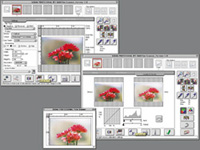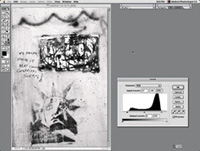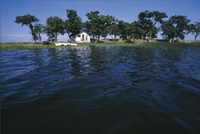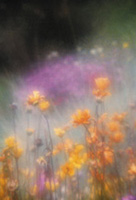Kodak Professional RFS 3600 Film Scanner
Early last fall those of us who attended the Seybold Conference in San Francisco were surprised by Kodak's new futuristic looking 35mm film scanner for the consumer market. Kodak has been making scanners for photo labs and service bureaus for many years, so a consumer 35mm scanner is a logical move, of course. The RFS 3600 offers 3600dpi resolution, 12-bit scanning depth, and a 3.6 dynamic range. Priced at $1299 it makes for a very attractive package. In addition to its swoopy shape, Kodak applied some original and independent thinking to the RFS 3600 design. The power supply was not put inside the scanner--it's an external solid state device that effectively removes a source of heat and vibration from the scanner. The film carriers are stationary, with a slide holder in the front and a motorized film strip holder accessible from the side. |
|||
Unlike other 35mm scanners, the film is scanned by the movement of the CCD sensor and light source. Even the feet of the scanner are made of non-slip, vibration-dampening material. The slide scanning function also includes an autofocus adjustment to compensate for differences in slide mount thickness. The interface with a computer, including support for the PC Windows and Macintosh platforms, is a choice between SCSI 2 and USB. Kodak has included their own advanced technology to provide internal image processing in the RFS 3600 scanner. This includes an automated image adjustment capability as well as the use of their proprietary Film Terms to interpret the characteristics of different kinds of film images. Testing The Kodak RFS 3600 |
|||
I tried again, and again, and had to come to the conclusion there was a bug in the RFS 3600 plug-in for the Mac. So I then installed the software on my PC Windows 2000 workstation, this time using the SCSI interface selection. Wouldn't you know, the same thing happened using the TWAIN driver from within Photoshop. It crashed the application during data transfer to the Photoshop workspace. Just to be sure it was not Photoshop, I also opened the RFS 3600 TWAIN driver in Corel PHOTO-PAINT 9 and went through the process of making a scan. Again, the same result. The scanner software crashed the host application. Of course I was immediately on the phone to Kodak. Just a few days later I received a new upgraded version of the software and firmware for the scanner. In the meantime I laid out a diverse selection of slide, color negative and black and white films, particularly including Kodak's latest Supra and Portra films to scan. When the new software arrived I installed it and the problem that caused the crashes was resolved. I scanned the films using only the automatic internal adjustment as well as the tools for adjustment provided in the software to output a sizable number of full-frame 3600dpi scans. |
|||
My experience with these scans was quite mixed. The internal Kodak processing that's a part of the RFS 3600 made scans from the Supra film incredibly effective. The scans were also very good with other Kodak films and even Agfa and Fuji color negative films. These interpreted as well if not better than what I have experienced with just about every other scanner driver software for the consumer realm. I also worked with slide and black and white films but support for these films is lacking. Black and white negative films scanned with the RFS 3600 are output as three channel RGB color files with slight to distinct coloration, particularly in dark tones. The RFS 3600 software drivers, either the Photoshop plug-in for the Macintosh or the TWAIN driver for Windows, does not produce a scalable window interface. On a typical graphics workstation with larger monitors set at 1024x768 or 1182x870 pixels resolution, the RFS 3600 driver window is barely more than a fourth of the screen. As a result the pre-scan preview image window is no more than a large thumbnail, and even the zoomed preview window accessible from the adjustment tab interfaces is so low in resolution that the eyedroppers provided to select black, white, and mid-tone points are all but useless. |
|||
The RFS 3600 can scan strips of 35mm film and supports batch scanning. The pre-scan previews of a six frame strip can be accomplished in one action by clicking the appropriate icon control button. However, with every strip I previewed this way (even though the first frame was accurately placed), the successive frames were inaccurately placed on the basis of the automatic pre-scan processing. This meant each frame in a strip had to be individually adjusted for placement right to left, and then individually pre-scanned, which precluded the possibility of doing a batch scan of a strip of film. Conclusions And Recommendations |
|||
Personally I'd buy this new Kodak RFS 3600 in a minute, even though I have a perfectly satisfactory 4000dpi scanner. Why? Just for the access to the excellent Kodak color negative interpretation capabilities. But the software precludes that possibility. This Kodak scanner has great promise, but its Achilles' heel is software that's not ready for prime time. For more information on the Kodak Professional RFS 3600 scanner call Kodak at (800) 235-6325 or visit their web site at: www.kodak.com/go/professional. |







































